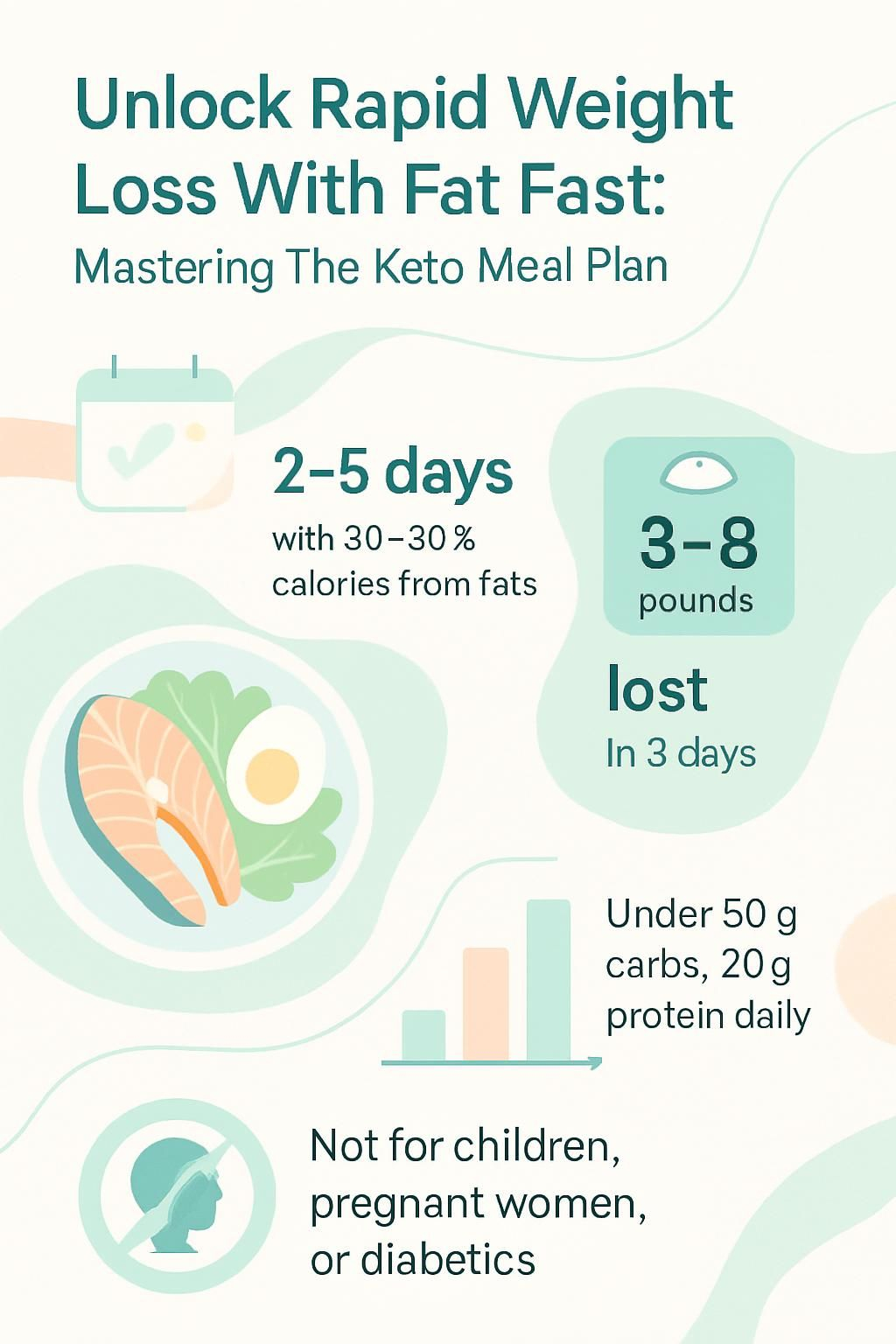Unlock Rapid Weight Loss With Fat Fast: Mastering The Keto Meal Plan
Our Nutrition Assistant AI Suite will transform your body. You will lose fat, get toned, and build muscle. Gain confidence and optimal health.
Feeling stuck with weight loss on your keto diet? A short fat fast can help reset your progress and push you back into ketosis, the state where your body burns fat for energy instead of glucose. Used for only a few days, this targeted method can deliver quick results while you get your routine back on track.
In this article, you will learn what a fat fast is, who might try it, how it works with a keto meal plan, what to eat on a fat fast, and how to do it safely. You will also find tips to avoid common mistakes and answers to frequent questions. Rapid weight loss is possible, but smart planning protects your health.
Key Takeaways
- Fat fasting is a short-term keto strategy lasting 2 to 5 days. About 80 to 90 percent of calories come from fat with a total daily intake of 1,000 to 1,200 calories.
- Rapid weight loss of about 3 to 8 pounds in three days is common due to ketosis. Much of the early change is water weight, so results fade without continued keto habits.
- Safe fat fasting keeps carbs very low and protein minimal. Many plans limit carbs to well under 20 to 30 grams and protein to under 20 grams per day, using foods like oils, avocado, and high fat dairy.
- Risks include nutrient gaps, electrolyte loss, fatigue, and rebound weight gain. Discuss any fat fast with a healthcare professional first, especially if you take medicine.
- Fat fasting can break a weight loss plateau on a ketogenic diet. It is not advised for children, pregnant or breastfeeding women, people with heart disease, or anyone with diabetes without medical supervision.

What Is Fat Fasting?

Fat fasting is a short keto method that nudges your body to burn fat for fuel instead of glucose. It is structured, not a total fast, and it can help you re-enter ketosis quickly after a stall or a high carb day.
What is fat fasting and what is its purpose?
Fat fasting is a brief eating plan where 80 to 90 percent of your daily calories come from fat. You follow it for two to five days while keeping total calories near 1,000 to 1,200 per day.
The goal is to trigger ketosis fast. In ketosis, the liver makes ketone bodies from fat. Your cells then use these ketones for energy instead of glucose from carbs.
This switch speeds up lipolysis, the breakdown of stored fat. People often use the fat fast after a cheat day or to break stubborn weight plateaus on a ketogenic diet. The idea dates back decades, when researchers studied how extreme macronutrient shifts affect energy and blood sugar.
It is not a long-term nutrition plan. It is a focused reset that can change body composition quickly, then you return to a standard keto meal plan.
With the fat fast technique, you rapidly swap carbs for healthy fats to trigger intense fat burning.
How is fat fasting different from traditional fasting methods?
On a fat fast, you eat. Traditional fasting often means no calories at all or time-restricted eating windows. A fat fast sets strict calories and a high fat ratio instead of full abstinence.
During a fat fast, aim for 1,000 to 1,200 calories per day. About 80 to 90 percent should come from fat sources like avocado, butter, or coconut oil. Carbs stay very low and protein stays minimal, often under 20 grams per day.
Classic fasting methods such as water-only or time-restricted feeding limit overall intake but do not target fat as the main macronutrient. A fat fast targets ketone production, which can push ketosis more quickly than simple calorie restriction.
In short, fat fasting focuses on macronutrient ratios, not just eating less food.
What is the science behind fat fasting and ketosis?
Fat fasting drives lipolysis, the release of triglycerides from fat tissue into fatty acids and glycerol. With very low carbs, blood glucose drops and insulin falls. The liver converts those fatty acids into ketones.
Cells switch to ketones for fuel. This metabolic state is called ketosis. Many people reach it within 2 to 6 days on a fat fast or well-formulated ketogenic diet.
High dietary fat speeds ketone production because there is little glucose to use. As ketones rise, the body relies more on stored fat for energy.
How Does Fat Fasting Work?
Fat fasting uses a very high fat intake to flip your main fuel source. Think of it as a short bridge back to steady ketosis.
What is the macronutrient breakdown for fat fasting?
Follow a strict macronutrient split. About 80 to 90 percent of your calories should come from fat rich foods such as olive oil, heavy cream, cream cheese, macadamia nuts, or fatty fish.
Keep protein and carbs very low. Many plans limit protein to under 20 grams and carbs to very low levels per day. Most people also keep calories near 1,000 to 1,200 in total.
This high fat approach helps many enter deep ketosis and burn body fat quickly. Dr. Robert Atkins wrote about this strategy early in the rise of ketogenic dieting, highlighting the high fat content as the defining feature.
How long should a fat fast last and what are the calorie guidelines?
A fat fast should last no more than 5 days. Many people do it for 2 to 4 days to limit risks like lean muscle loss.
Plan four to five small meals per day. Each meal has about 200 to 250 calories, which keeps your daily total near 1,000 to 1,200 calories.
Meals focus on fat, for example avocado slices, cream cheese bites, or tablespoons of coconut oil. After a cheat day, following these targets helped me restart ketosis without feeling wiped out. Extending past five days raises the chance of fatigue and a slower metabolism.
Summary: a fat fast usually runs two to five days with 1,000 to 1,200 calories split into several small, high fat meals.
How does fat fasting make the body burn fat for fuel?
Very low carbs and calories create a fast shift in fuel use. Glycogen, the stored form of glucose, gets used up, which lowers insulin and frees fatty acids from fat stores.
The liver converts those fatty acids into ketones. Appetite often falls after one to three days as the body adapts to burning fat.
During my last fat fast, I felt steady energy and fewer snack urges. Lower insulin supports deeper ketosis, which can drive rapid weight changes.
Benefits of Fat Fasting
Fat fasting can help break a plateau and tighten your keto routine. A small change in inputs, a big nudge to your metabolism.
How does fat fasting promote rapid weight loss?
Many people lose 5 to 8 pounds in three days on a fat fast. That usually means a mix of water and body fat. A daily intake near 1,000 calories with up to 90 percent from fat creates a strong calorie deficit while preserving ketosis.
Using mostly monounsaturated fats like olive oil, avocado, and nuts can help keep energy stable. A friend used this approach after a keto stall and saw the scale move again within three days.
Can fat fasting help break through weight-loss plateaus?
Yes. Many hit a stall after several weeks on a keto diet. If your plateau lasts two weeks or more, a short fat fast can help.
Shifting back to fat for fuel can restart fat loss. Reports often show a 3 to 5 pound drop in three days. After a high carb weekend, this method can also speed re-entry into ketosis and restore momentum.
Keep the fat fast brief, usually two to five days. Hydrate well and track your intake to avoid nutrient gaps.
How does fat fasting boost metabolism?
Ketone levels rise quickly during a fat fast. This can mildly increase metabolic rate for a short period. With cells running on fat, insulin sensitivity may improve and blood sugar often drops.
Some people also see better lipid markers during a short protocol. High omega-3 choices like sardines, mackerel, and salmon can support heart health while you target ketosis.
In what ways does fat fasting enhance ketosis?
A fat fast raises fat to more than 80 percent of calories and slashes carbs. Many people reach deeper ketosis within 2 to 6 days as ketone production climbs.
With little glucose available, cells must burn stored fat and dietary fat for fuel. Signs such as reduced hunger or clear focus are common during this shift.
How does fat fasting reduce appetite?
High fat meals can trigger hormones that signal fullness. During a fat fast, about 80 to 90 percent of calories come from fats like avocado, olive oil, and nuts.
Ketosis often lowers ghrelin, the hunger hormone, which reduces cravings for many people. Eating four or five small high fat meals can also prevent blood sugar spikes and keep appetite steady.
What Are the Potential Risks and Side Effects of Fat Fasting?
Fat fasting is powerful, but it is not risk free. Know the tradeoffs so you can decide wisely.
What nutrient deficiencies might occur during fat fasting?
Because a fat fast limits many foods, you may miss vitamins and minerals such as vitamin C, magnesium, potassium, calcium, and iron. Cutting vegetables, beans, fruit, and whole grains lowers dietary fiber too.
Very low protein can also stress skeletal muscle, which needs amino acids for repair. Keto flu symptoms, like headache or fatigue, can appear if electrolytes drop.
A short multivitamin and careful planning can help during a brief protocol. This method is not meant for extended use without medical oversight.
How can fat fasting cause electrolyte imbalances?
Rapid water loss can flush sodium and potassium from your body. As ketones rise, they are excreted in urine, which can pull electrolytes with them.
Dizziness, fatigue, or cramps may follow. Adding salt to meals and choosing potassium-rich, low carb foods can reduce these issues during a short fat fast.
Why might fat fasting lead to fatigue and low energy?
Electrolyte loss is one reason. Another is low total calories and very low carbs, which can cause headaches, nausea, or constipation while your body adapts.
Minimal protein may also reduce muscle repair and exercise tolerance. Many people feel most tired on day two or three, then adjust as ketosis deepens.
What is the risk of rebound weight gain after fat fasting?
Some regain happens once you return to regular eating. Two to three pounds often come back as glycogen and water are restored.
To keep progress, shift into a standard keto meal plan right away. Returning to high carb foods can erase results quickly.
Who Should Try Fat Fasting?
Certain keto dieters may benefit from this focused reset. Safety and fit depend on your health history and goals.
Who are the ideal candidates for fat fasting?
If you follow a ketogenic diet and hit a weight loss plateau, fat fasting may help. It can also support quick re-entry into ketosis after a cheat day or holiday meal.
It is not a good choice if you have very little fat to lose or if you have cardiovascular disease without a doctor’s oversight. Talk with your healthcare provider to see if it matches your needs.
Which health conditions might benefit from fat fasting?
Under medical care, a short fat fast may help people with severe obesity who have not responded to other diet changes. Some individuals with poor insulin sensitivity may see short-term drops in blood sugar.
Short protocols can also lower markers of inflammation in certain cases. Strict supervision matters if you have chronic conditions.
If you are stuck on a keto plateau, this method can serve as a brief reset. Check with your clinician before you start.
Who Should Avoid Fat Fasting?
For some, fat fasting carries more risk than reward. Knowing that ahead of time prevents problems.
Which medical conditions make fat fasting unsafe?
Type 1 or type 2 diabetes can make a fat fast unsafe without close medical supervision. Blood sugar changes can be sudden. People with heart disease or endocrine disorders should avoid it unless a doctor approves.
If you have a history of eating disorders, restrictive plans may trigger unhelpful behaviors. Pregnant or breastfeeding women need steady nutrition and should skip any fat fast.
Cholesterol hyper-responders may see sharp rises in cholesterol on high fat intakes. Medical guidance is essential in these cases.
When should you avoid trying fat fasting?
People taking medicines for chronic conditions should not attempt a fat fast without talking to a clinician. If you tend to have low potassium, magnesium, or sodium, the plan may worsen those issues.
Stop if you feel dizzy, weak, or unwell. Children, pregnant women, and anyone with an eating disorder should avoid this type of fasting.
After an illness like the flu, wait until you fully recover. I once tried a strict fat fast after being sick, and the fatigue made recovery harder.
Foods to Eat on a Fat Fast
Aim for simple, high fat foods with very low net carbs. These choices support ketosis and keep hunger in check.
What are healthy fats suitable for fat fasting?
Choose fats from both plant and dairy sources. Coconut oil provides medium-chain triglycerides, which are quickly turned into ketones. Olive oil is rich in monounsaturated fat and works well on salads or cooked vegetables. Avocado oil tolerates higher heat.
Butter, heavy cream, cream cheese, and high fat cheeses add flavor and calories with very few carbs. Full fat coconut milk or coconut cream offers variety. Mayonnaise made with olive or avocado oil boosts intake with little prep.
During one reset, adding butter to coffee helped me stay full while hitting my targets. These fats help you feel satisfied without raising blood sugar.
Healthy Fats for Fat Fasting
| Fat Source | Calories per Tbsp | Grams of Fat | Net Carbs |
|---|---|---|---|
| Coconut oil | 120 | 14 | 0 |
| Olive oil | 119 | 14 | 0 |
| Avocado oil | 124 | 14 | 0 |
| Butter | 102 | 12 | <1 |
| Heavy cream | 51 | 5 | <1 |
| Cream cheese | 50 | ~5 | ~1 |
Use these fats to stay energized while following your daily calorie targets.
Which non-starchy vegetables are recommended?
Cucumbers pair well with sour cream or cream cheese dips. Avocados are an excellent choice thanks to their fiber, healthy fat, and low net carbs. Half an avocado contains about 2 grams of net carbs.
Lettuce makes a great base for salads with fatty fish like salmon or sardines mixed with mayo. I like crisp romaine wraps filled with tuna and homemade mayo for a fast lunch.
These simple vegetables add texture and help you stick to your plan after a cheat day.
What keto-friendly snacks and beverages can you have?
Keep snacks high in fat and low in carbs. Fat bombs made with coconut oil and nut butter deliver quick energy. Sugar-free gelatin topped with real whipped cream can satisfy a sweet tooth.
Enjoy one ounce of macadamia nuts, or blend macadamia butter with cream cheese for something savory. Many find these options reduce cravings and steady energy.
Choose drinks that fit your keto meal plan. Ketoproof coffee with butter and MCT oil offers a creamy start. Iced ketoproof green tea is a light pick-me-up without sugar.
Whipped heavy cream with a sugar-free flavoring feels like dessert and still keeps carbs low.
Foods to Avoid on a Fat Fast
Certain foods can knock you out of ketosis fast. A little planning prevents most setbacks.
Which high-carb foods should be avoided?
Avoid grains and cereals like bread, pasta, rice, oats, and crackers. These raise blood sugar and will likely stop ketosis. One slice of white bread has about 13 grams of carbs.
Beans and lentils are also high in carbs despite their protein. Lentils have around 40 grams per cup, black beans about 41 grams, and lima beans about 30 grams.
Limit fruit to tiny portions of berries if needed. Skip starchy vegetables like potatoes and corn. Once, I ate half a baked sweet potato during a reset and my ketone reading dropped the next morning.
Avoiding these items helps you continue burning stored fat for fuel.
Why avoid sugary snacks and drinks?
Sugary snacks like cookies, cakes, pastries, and candy cause quick glucose spikes. Even small amounts can disrupt ketosis.
Sweetened drinks, including juice, energy drinks, and sweet coffee, raise blood sugar and insulin. During one three-day fat fast, I noticed energy dips from a flavored water that had hidden sweeteners.
Keeping daily net carbs very low, often under 10 to 20 grams, helps you stay in ketosis and use fat for energy.
Why limit high-protein foods during fat fasting?
High protein foods such as beef, chicken, cod, and lamb are restricted. Protein intake stays under about 20 grams per day so fat remains the primary fuel.
Extra protein can be turned into glucose through a process called gluconeogenesis. That reduces fat burning. During my last fat fast, small portions of tuna and turkey helped me reach deeper ketosis faster.
Sample 3-Day Fat Fasting Meal Plan
A simple three-day outline can remove guesswork and keep your macros tight. Use it as a template, then adjust for taste and calories.
What are good meal ideas for Day 1?
Start with ketoproof coffee, brewed coffee blended with coconut oil or butter. As a breakfast or snack, make spiced bacon deviled eggs with mayo and mustard.
For midday, try pizza fat bombs made from cream cheese, Italian herbs, and pepperoni. Dinner can be cheesy creamed spinach cooked with heavy cream and melted cheese.
This sample day delivers about 1,076 calories with 10.98 grams total carbs, 6.54 grams net carbs, 30.76 grams protein, and 102.59 grams fat. About 85.8 percent of calories come from fat. I have used a similar layout to control hunger and keep energy steady during a plateau break.
What simple snacks and keto meals work for Day 2?
Start your morning with iced ketoproof green tea for a lighter option. Snack on two jalapeño popper fat bombs for flavor and almost zero net carbs.
At lunch, fill half an avocado with egg salad for creaminess and fiber. For dessert or a snack, make keto mocha mousse with heavy cream.
Totals for this day are about 1,036.95 calories. About 86.9 percent of calories come from fat, with 10.79 grams net carbs and 21.21 grams protein. This helps your cells continue burning stored fat between meals.
- Fat Fasting vs Traditional Keto: macronutrient ratios
- Sample Meal Plan Nutrition Facts
What tips help stay on track on Day 3?
Begin with ketoproof coffee to curb hunger early. Stick to the meal plan of salmon benny breakfast bombs, two pizza fat bombs, cheesy creamed spinach, and four coconut peanut butter balls.
Totals: 1,196.68 calories, 17.04 grams total carbs, 12.02 grams net carbs, 40.33 grams protein, and 110.39 grams fat. About 83 percent of calories come from fat.
Prep snacks ahead so you have something ready during cravings. Tracking helped me avoid impulse foods, which made day three smoother.
How to Safely Implement a Fat Fast
First say that fat fasting is a technique requiring careful planning to avoid possible health issues. Use fat fasting claim with expert advice for best results and safer outcomes.
How should you prepare your body for a fat fast?
Follow a strict ketogenic diet for several days before you start. Keep net carbs under 20 to 30 grams per day so your body is already leaning on fat for energy.
Plan for 1,000 to 1,200 calories with 80 to 90 percent from fat. Batch cook extra portions to reduce stress on busy days. When I prepared macadamia nuts, avocado, and coconut oil ahead of time, the process felt easier.
Drink plenty of water and consider an electrolyte supplement to avoid common keto flu symptoms.
Why is hydration and electrolyte balance important?
Fat fasting can cause rapid water loss. This may drain sodium and potassium, which can lead to headaches or fatigue.
Replacing fluids and minerals helps prevent cramps and weakness. Many people on keto benefit from extra salt, especially during the first few days of a fat fast.
How do you transition back to a regular keto diet?
After the fast, increase protein and non-starchy vegetables gradually. This helps prevent quick regain and supports stable energy.
Use a simple meal planner to map the next two weeks. Avoid high carb and processed snacks that can disrupt ketosis. A stepwise approach protects your results and lowers stress on your body.
Fat Fasting vs. Other Types of Fasting
Different fasting methods serve different goals. Choose the one that fits your timeline and needs.
How does fat fasting compare with intermittent fasting?
Fat fasting sets calories and macronutrients, aiming for rapid ketosis in two to five days. Intermittent fasting sets eating windows but does not require high fat ratios.
Fat fasting often resets ketosis faster, especially after extra carbs or illness. In my experience, it cuts cravings more quickly than time-restricted eating alone.
Intermittent fasting can support long-term weight management, but it may not trigger deep ketosis if your meals are high in carbs.
What are the benefits and drawbacks of each method?
Fat fasting can produce quick changes, often 1 to 2 pounds per day for a short period. Appetite may drop and focus may improve. It is not meant for long-term use due to risks like nutrient gaps and rebound weight gain.
Intermittent fasting is flexible and easier to maintain over months. Side effects are usually milder. It may not break a stubborn plateau as fast, but it fits more lifestyles and health situations.
Choose based on your health profile, timeline, and support system.
Tips for a Successful Fat Fast
A little prep goes a long way. Build simple routines that keep your plan on track.
How can planning meals ahead improve your fat fast?
Planning ensures you hit 1,000 to 1,200 calories and keep fat at 80 to 90 percent. Prep 4 to 5 mini meals at 200 to 250 calories each.
A set menu prevents guesswork, lowers grocery trips, and reduces carb mistakes. Tracking makes it easier to keep ketosis steady while you burn fat for fuel.
Why is it important to listen to your body’s signals?
Pay attention to symptoms like dizziness, fatigue, or stomach issues. These may signal dehydration, low electrolytes, or a need to stop.
If you feel unwell, end the fat fast and talk to a clinician. During one reset, a mild headache reminded me to add fluids and salt, which helped within hours.
What common mistakes should be avoided?
Do not extend a fat fast past five days. The risk of muscle loss or nutrient gaps rises with time.
Do not skip hydration or electrolytes. Avoid hidden carbs and excess protein, which can kick you out of ketosis. Planning meals and snacks helped me avoid these pitfalls and stay consistent.
Key Takeaways for Mastering the Keto Meal Plan
Fat fasting can be a precise tool within a keto diet. Used carefully, it can reset momentum and support deeper ketosis.
How does fat fasting support weight loss and ketosis?
Calories stay low at 1,000 to 1,200, and 80 to 90 percent of those calories come from fat. This pushes your body to burn stored fat for fuel and raises ketone levels quickly.
Many people lose 5 to 8 pounds in three days, a mix of water and fat. Small, frequent meals with low protein help protect lean tissue. During my last three-day reset, energy improved and the scale dropped almost six pounds.
Why should you consult a healthcare professional?
Talk with a clinician before you start, especially if you live with diabetes, heart disease, endocrine disorders, or a history of disordered eating. Medicines and medical conditions can change how your body responds.
Evidence on fat fasting is still limited. A healthcare professional can tailor advice to your situation and reduce the chance of problems like hypoglycemia or low blood pressure.
FAQs About Fat Fasting
Clear answers reduce guesswork and help you use this method wisely.
What are common questions and misconceptions about fat fasting?
Fat fasting is not the same as not eating. You still eat high fat foods in small amounts, which can drive ketosis faster than a standard fast.
It is not a long-term plan. Most people see a temporary drop of 2 to 3 pounds after the fast ends. Spacing out fat fasts prevents nutrient gaps and fatigue. During my first attempt, I felt weak by day three because I ignored electrolytes.
How often can you safely do a fat fast?
Use it occasionally, for example to break a weight stall or restart ketosis. Limit each fat fast to no more than five days.
Doing it too often can drain energy and cause headaches, dizziness, or muscle weakness from low electrolytes. Many nutrition experts suggest waiting several months between fat fasts for safer results.
Conclusion
Fat fasting can jumpstart rapid weight loss within a keto diet and nudge you into deeper ketosis. Keep it short, focus on healthy fats, stay hydrated, and track your intake for best results. Then transition back to a balanced keto meal plan to maintain progress.
If you have any medical condition or take prescriptions, speak with a healthcare professional first. Careful planning keeps this tool effective and safe.
Evidence note: Research shows ketogenic diets can suppress appetite and improve glycemic control in some adults, which supports short-term strategies like a fat fast. See peer-reviewed summaries from major medical libraries and public health schools.
FAQs
1. What is the Fat Fast and how does it support rapid weight loss on a ketogenic meal plan?
The Fat Fast is a short-term, high-fat eating strategy that limits daily calories to about 1,000 while raising fat intake to around 80-90 percent of total calories. This approach helps the body enter ketosis quickly, which can promote faster weight loss by encouraging the use of stored fat for energy. Research shows that ketosis may increase satiety and reduce appetite, supporting calorie control during weight loss efforts (Westman et al., 2002).
2. How long should someone follow the Fat Fast within a keto meal plan?
Most experts recommend following the Fat Fast for no more than three to five days due to its restrictive nature. Prolonged use may lead to nutrient deficiencies or muscle loss. After completing this phase, individuals often transition back to a standard ketogenic diet with higher protein and vegetable intake.
3. Are there risks or side effects linked with using the Fat Fast method?
Possible side effects include fatigue, headache, nausea, or constipation as your body adapts to fewer carbohydrates and higher fats. People with certain health conditions such as diabetes or kidney disease should consult their healthcare provider before starting any extreme dietary changes.
4. Can you share an example of real-life results from using the Fat Fast on a keto meal plan?
A recent case involved an adult who used the Fat Fast after experiencing a plateau on their standard ketogenic regimen. Over four days, they lost two pounds and reported reduced cravings. These results align with clinical findings showing that very low-carb diets can help break through weight loss stalls (Paoli et al., 2013).
Summary: The Fat Fast can help speed up entry into ketosis and may break through weight loss plateaus when used carefully in combination with a ketogenic eating pattern. Short duration and medical guidance are important for safety and effectiveness.







